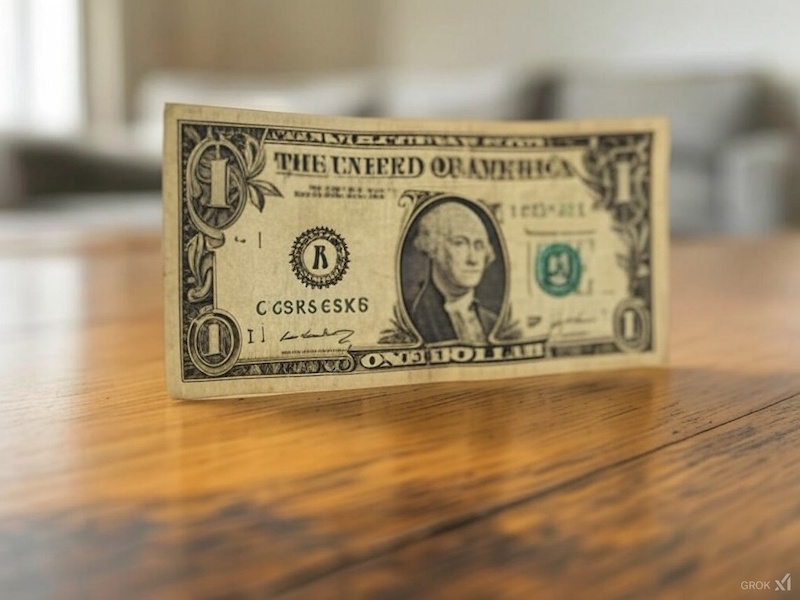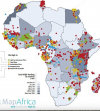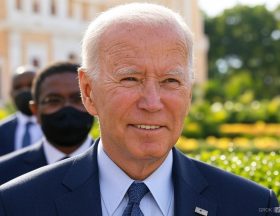The idea of freeing itself from the US dollar is not new in Africa, but it has gained ground in recent years. In a context marked by high volatility of local currencies, constraints on access to financing in hard currencies and a persistent dependence on imports denominated in dollars, the issue deserves an in-depth analysis. And if abandoning the greenback is more complex than it seems, alternatives have emerged in recent years on the continent.
It is the symbol of American economic hegemony: the dollar, master of international trade, is both a weapon and a prison. Everywhere in Africa, the observation is the same: dependence, volatility and vulnerability.
On the continent, the dollar reigns supreme. Almost all strategic imports – oil, wheat, medicines – go through it.
Debts are contracted in dollars, trade between states is settled in dollars, even the price of fuel at gas stations depends on its value. The dollar, which represented 57.4% of global foreign exchange reserves in the third quarter of 2024, according to the IMF, is involved in about 88% of currency exchanges worldwide, according to the Bank for International Settlements (BIS). It dictates the prices of essential African imports.
The problem is that this dependence is expensive. Very expensive. With each rate hike by the US Federal Reserve (FED), economies falter.
With each fluctuation of the greenback, public debts explode. In sub-Saharan Africa, about 40% of public debt is external, and more than 60% of this debt is denominated in dollars, according to the IMF. This reality increases the vulnerability of African economies to fluctuations in the American currency.
Nigeria, for example, spent several billion dollars in 2023 to stabilize a collapsing naira, only to have to let it fall by 40%. In Ghana, the depreciation of the cedi, which lost nearly 30% of its value in the same year on the interbank market, was enough to plunge the country into a debt crisis.
In Egypt, the depreciation of the Egyptian pound against the dollar pushed inflation to more than 30% in 2023. Kenya spent nearly 60% of its tax revenue on debt servicing in the 2022-2023 financial year, a situation exacerbated by the rise of the dollar and the depreciation of the Kenyan shilling.
So, voices are being raised. It is a question that still agitates chancelleries and makes economists on the continent dream. Is the dollar, the undisputed king of international trade, stifling African ambitions? What if we did things differently? What if we finally ditched the dollar?
Not just in Africa, but especially around the world. Covid-19, the Russo-Ukrainian conflict, the trade wars launched against China and the sanctions against certain countries that are adversaries of the United States have accelerated the de-dollarization process.
Today, while the greenback still represents 57.4% of global foreign exchange reserves, it has been constantly declining since the 2000s, when it exceeded 70%. Central banks are diversifying their portfolios, integrating the euro (26% of reserves), the yen and even the Chinese yuan, which is slowly but surely growing, as well as gold.
Swap agreements: first breaches

Some African countries, tired of suffering the all-powerful dollar, are now exploring alternatives to regain control of their economic sovereignty. China, the continent’s main trading partner, is leading the way by encouraging its partners to use the yuan.
In 2023, Sino-African trade reached $282 billion and already $167 billion in the first half of 2024, making Beijing a key player. Now, nations such as Egypt, South Africa, Nigeria and Mauritius pay part of their Chinese imports in local currencies or directly in yuan. These steps, while still modest, nevertheless chart an ambitious path.
Nigeria was among the first to embark on this transition. In 2018, the West African giant signed a currency swap agreement with China, allowing the two countries to trade in naira and yuan, without going through the dollar. This mechanism, worth 15 billion yuan (around $2.4 billion), has helped ease pressure on Nigerian foreign exchange reserves.
At the end of December 2024, Abuja renewed this agreement for three years, still for the same amount. A breath of fresh air for an economy shaken by the fluctuations of the naira, which continues to collapse against the dollar.
In Zambia, the initiative has taken a more direct turn. In 2023, the country has decided to use the yuan exclusively for its trade transactions with China.
This measure aims to reduce conversion costs and limit the impact of dollar volatility on an economy weakened by a restructuring of its external debt, particularly to Beijing. By giving up the greenback for these exchanges, Lusaka hopes to restore a certain stability and diversify its financial mechanisms.
China is not alone in this area. The United Arab Emirates, although more discreet, is establishing itself as a strategic partner for certain African countries. In 2023, Egypt concluded a swap agreement with Abu Dhabi worth 5 billion dirhams (around 1.36 billion dollars).
This agreement has allowed Cairo to limit pressure on a plummeting Egyptian pound, while ensuring its essential supplies of oil products. In 2024, Ethiopia followed suit by signing a similar agreement with the Emirates, strengthening its economic relations with the Gulf.
These mechanisms, although limited in volume for the moment, reflect a clear desire of several African states: to free themselves from the yoke of the dollar.
Local and regional solutions: AfCFTA and PAPSS
However, the dynamic of de-dollarization is not limited to bilateral relations with external partners. On the continent itself, the idea of trade freed from foreign currencies is beginning to gain ground. Local initiatives such as PAPSS, a cross-border payment system launched by Afreximbank, are supposed to allow African companies to trade directly in local currencies, driven by the desire to break the vicious circle of dependency and rethink intra-African trade.
Coupled with the African Continental Free Trade Area (AfCFTA), the new payment system could revolutionize intra-African trade, currently limited to 17% of the continent’s total trade.
The potential is enormous, but the challenge is considerable: convincing economic and banking operators to adopt these tools, especially in a market that is still too fragmented. At last count, around ten central banks are already affiliated with PAPSS.
Asian markets: a timid but promising diversification
But the search for alternatives to the dollar goes beyond the simple framework of trade or foreign direct investment, the dynamics of which have been changing rapidly in recent years – the Chinese and the Emiratis have become the most dynamic providers of FDI on the continent.
It also extends to the financing of public debt, where the search for less restrictive solutions is pushing some African countries to explore new opportunities in Asia. A movement that is still discreet, but which could, in the long term, redraw the financing maps.
In October 2023, Egypt made a big splash by becoming the first African country to enter the Chinese bond market. With its sustainable Panda bonds – an Asian version of Eurobonds – Cairo raised 3.5 billion yuan, or nearly $479 million, for sustainable development projects.
Africa had already flirted with these markets. In 2018, Ghana considered issuing Africa’s first Samurai bond, a bold bet on the Japanese market. Ultimately, the project fell through. In the meantime, Kenya and Nigeria have also tried to position themselves, but have not taken the plunge.
Afreximbank, on the other hand, has taken the plunge. Last November, the pan-African bank raised $523 million, or 81.3 billion yen, in its first Samurai bond issue in Tokyo.
Between challenges and opportunities, building an African model
Getting rid of the dollar will not be easy, and that has never been the goal. Especially since several African currencies are pegged to a basket of currencies in which the dollar plays an important role. But to reduce the hegemony of the greenback, it will first be necessary to stabilize local currencies, diversify trading partners, undertake deep and difficult structural reforms, and strengthen financial infrastructure.
This, while 45% of cross-border payment flows go through the SWIFT network, a system largely dominated by dollar transactions, which should be even more pronounced on the continent.
At a time when the global economic order seems to be in turmoil, the continent has a unique opportunity to rethink its model and write a new page in its economic history, while avoiding falling into new traps. The quest for autonomy cannot be summed up as replacing one dependency with another.
Above all, betting on the yuan, even though China is the continent’s leading trading partner, could result in a new form of disguised yoke.
Africa must learn from its history and prioritize solutions that strengthen its economic sovereignty by valuing its local currencies and promoting ambitious regional financial integration.
The dollar remains the master, for now. But history has taught us that no empire is eternal. It is up to Africa to build its own, on solid and sustainable foundations.
































Réagissez à cet article